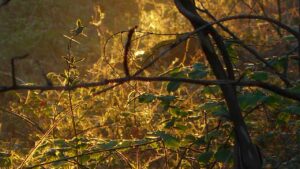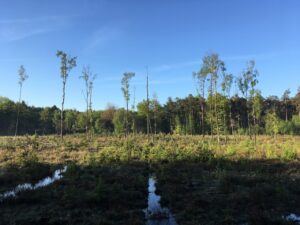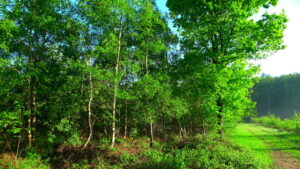On Armistice Day, Luke Turner talks to foremost field recordist Chris Watson about capturing birds, trees, and the horrors of war in sound.

Back in 2018, sound recordist and artist Chris Watson performed an installation to mark the centenary of the end of the First World War at Newcastle’s Boiler Shop venue, where the Stephenson family built many of the first railway engines of the Industrial Revolution. A Nightingale on the Western Front began just before dawn on the 11th November and, in this place that had once thundered with the machines that would contribute to making the First World War the most brutal and costly in history up to that point, filled the room with the sound of birds, trees and animals. This wasn’t a mere balm, however, with pleasant ‘nature’ a contrast to thoughts of the sound of violence, but left space and silence in which to contemplate the horrors of that, and subsequent, warfare.
A while afterwards I interviewed Chris Watson about the piece as part of my research for an essay in the Gifts of Gravity and Light anthology of nature writing responding to the theme of ‘Autumn’. In the end, the essay took on a different tone and focus around sexuality, woodland and the desecrated landscapes in the war poetry of Siegfried Sassoon, but given that a Chris Watson interview should never be kept from the world, I’ve written it up here thanks to the good people of CBTR.
To create A Nightingale on the Western Front, Watson made recordings over the course of a year at various First World War battlefields across the landscape of Flanders. “The seasonal cycle was important,” he told me. The first recordings were made in October on trips out from a film project in Brussels to the old Flanders battlefields, with further visits in the following year. Watson focussed on woodlands, which were often where the heaviest fighting took place as they offered rare cover in the flat, open landscapes of the north of France and Belgium. On a school history trip in the early 90s, I visited what was literally called Sanctuary Wood, located a few kilometres outside Ypres. Battered by artillery barrages, these woodlands became hellscapes of shattered tree trunks, craters and mud, vividly captured by the artist Paul Nash in paintings such as the bleakly ironic ‘We Are Making a New World’. Many, if not most, of the soldiers from all the nations involved in the First World War would have had a strong connection to woodland, either from their own lives working as rural labourers (my great grandad, Ted Turner, gassed during the war, was a gardener and farm worker) or, if they were from the urban working class, one or two generations away. The destruction must have added to the sense that industrial warfare was a grotesque affront to nature, and the human body within it.

In the woods where Watson recorded, very few trees there were less than a hundred years old, and the topography was still marked with the evidence of fighting. These areas of mixed woodland make for oases amidst the surrounding arable farmland, which is largely empty aside from the crows and skylarks that have become so much a part of our sonic, cultural memory of the First World War. A Nightingale on the Western Front began in October, a time of transition for avian life just as it is for us. “The thing to bear in mind in autumn, is that what surrounds these woodlands now is effectively barren farmland, like a snooker table, and everything piles in there at dusk, so it’s a good place for foxes, tawny owls, crows, jays, magpies, rooks, jackdaws, chaffinches. At that time of year robins start to sing again, in these beautiful solo songs.” Robins are very territorial and are in fact one of the few species where both male and female sing during the autumn and early winter. “They’re not singing like the males do in spring to attract a mate, they establish their territory and defend it with song,” Watson explains. Perhaps in the liquid burble of the robin’s aggressive melodies, we hear something closer to the animal instinct for violence than we do in the skylark more traditionally associated with trench warfare.
The piece eventually focussed on the nightingale because it too has a solo song. Like the robin, the nightingale is a territorial bird, and he speculates that there could potentially be a genetic link between those he recorded and their ancestors who sang among the rifle bullets and shellfire. Watson was also able to make a political point through the nightingale: “I was interested in the cacophony and overwhelming sound of the dawn chorus, but also being able to isolate it down to one bird, an iconic bird and a migrant bird as well,” Watson said, “One of the things I discovered for myself was that fifty different nations fought over that land, it wasn’t just the Germans, French and British. At the time, migration was in the news, and I was interested that this was a very welcome migrant that comes from sub-Saharan Africa and chooses to come to these places.”
Watson spent the night at the site seeking nightingales in the pitch dark, putting microphones out in the woods and running cables back to the car. “That was very full on, you get very focussed when it’s pitch black and you’re listening – you respond to every sound, even if it’s a wood mouse it sounds like someone rummaging through the forest. I certainly thought then about what had happened in that place a century ago, and the contrast with that moment, not thinking about anything else, just listening, really carefully.”

Did this intense process, spending nights in the woodland, senses open give a different insight on the place and what happened there, a century before? “It’s hard because you can’t possibly put yourself in the place, it’s incomprehensible what happened there, even though we’ve all seen it depicted so much,” Watson said. “It really upset me, and I got a handle of the loss of life and destruction. You’d go past these tiny villages with just two or three farms and there’d be two or three thousand graves; you’d go a kilometre to the next village and there’d be another one, with two or three thousand graves, it was just endless.” In another way, the tiny voices of the birds that endure with no memory of the carnage of the First World War and the violence that continues between humans today, and probably always will, gives a sense of how preposterous it all might seem. “It’s sickening and depressing, but the only good thing is perhaps to see what has survived, like the birds that are exactly the same as during the war, if a little fewer due to the agriculture,” he says. That hundred years is “a blink of an eye” in evolutionary terms and, as Watson puts it, “other things just get on with it, evolve and change, and we’re insignificant in that time”.
*
Luke Turner’s most recent book ‘Men At War – Loving, Lusting, Fighting, Remembering 1939-1945’ is a critically-acclaimed examination of masculinity and sexuality during the Second World War. His first book, ‘Out of the Woods’, was shortlisted for the Wainwright Prize for nature writing, and he is co-editor and co-founder of The Quietus. Find more of his stuff here.